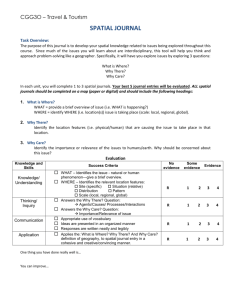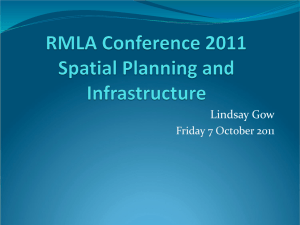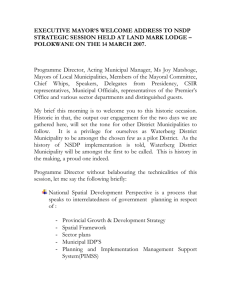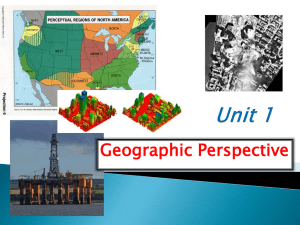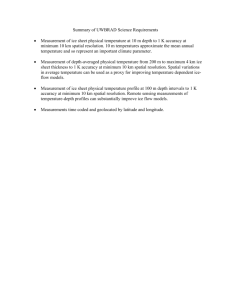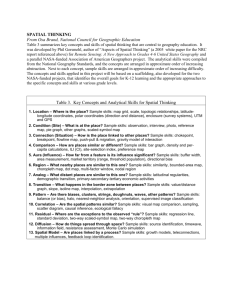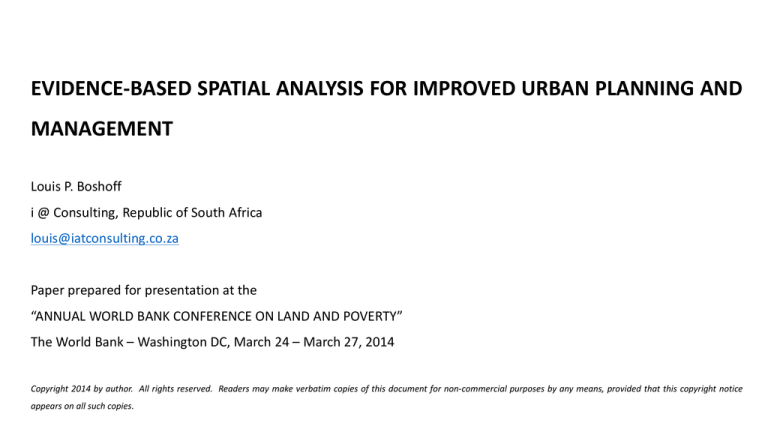
EVIDENCE-BASED SPATIAL ANALYSIS FOR IMPROVED URBAN PLANNING AND
MANAGEMENT
Louis P. Boshoff
i @ Consulting, Republic of South Africa
louis@iatconsulting.co.za
Paper prepared for presentation at the
“ANNUAL WORLD BANK CONFERENCE ON LAND AND POVERTY”
The World Bank – Washington DC, March 24 – March 27, 2014
Copyright 2014 by author. All rights reserved. Readers may make verbatim copies of this document for non-commercial purposes by any means, provided that this copyright notice
appears on all such copies.
PURPOSE OF THIS PAPER
• This paper demonstrates innovative spatial means to enhance municipal revenue streams within existing tax
systems and affordability limits that can contribute to finance efforts to alleviate the urban poverty problem.
• Furthermore, since the focus is on municipal revenue applied to urban poverty alleviation, it is assumed that
funds earmarked for urban poverty alleviation are to be spend on shaping an urban structure that provides
affordable and efficient accommodation and transportation to the poor, and decent access to employment
opportunities.
• This begs the question as to whether urban planning is successful in the optimal utilisation of funds allocated to
uplifting the poor.
• This paper therefore also tests some policy and planning assumptions to addressing urban poverty in South Africa
following an evidence-based approach.
METHODOLOGY
• Relational databases were constructed that enabled
spatial modelling and analysis, inclusive of:
• spatial accessibility analysis;
• Bid rent analysis;
• gravity analysis; and
• spatial overlays to assess municipal revenue,
expenditure and outstanding debt spatially.
• Datasets employed for purposes of modelling,
presentation and analysis were selected at the hand
of the following criteria:
• the nature of the datasets must respond to the
research questions posed;
• data must be commonly available to each South
African city without the need to conduct primary
research, to allow for easy replication of the
chosen methodology; and
• it must be possible to model and analyse the
data spatially.
HOW TO GET MORE FROM THE SAME PURSE
How to raise municipal own revenues without increasing intergovernmental
transfers, introducing new tax instruments or raising municipal rates and taxes?
APPROACH TO MUNICIPAL REVENUE OPTIMISATION
The proposed solution to municipal revenue optimisation entails:
1. Spatial reconciliation of data to ensure that all cadastre entities are accounted for at the actual land use;
2. Reconciliation between verified spatial data and the municipal property valuation roll (including supplementary
rolls) to ensure that all properties are reflected in the roll and rated at the correct land use;
3. Reconciliation between verified spatial data and the municipal billing system to ensure that the correct tariffs
are charged; and
4. Analysis of classification anomalies, properties not accounted for in the valuation roll and/or billing system,
high value outstanding debtors and potential improvements in revenue-related policies to optimise land use
classifications for revenue enhancement purposes.
BUFFALO CITY: RAISING REVENUE WITHOUT INCREASING TARIFFS IN AN ELECTION
BUDGET
• The Buffalo City Metropolitan Municipality required an additional R 70 million per month in revenue to finance
its 2014/15 election year expenditure budget, with limited scope to increase rates and tariffs.
• Shortly before finalisation of the budget the municipal property valuation roll was updated.
• The exercise identified 2 275 additional properties for inclusion in the valuation roll, and property sub-divisions
and consolidation were also dealt with.
• Additional property rate categories were created and a number of properties were reclassified.
• This resulted in revenue potential of R 847 million for the 2013/14 financial period, 25.48% more than the R 675
million property rates’ revenue originally projected for the same period, without raising property rates.
EKURHULENI METRO: MAGNITUDE OF INCOMPLETENESS OF REVENUE
• The Metropolitan area spans 179 093 hectares.
• Matching of the municipal property valuation roll to
cadastre data revealed that 42 934 properties
representing 37% of the area have not been included
in the valuation roll.
• Using averaged values across the entire valuation roll,
the market value of the properties omitted is R 519.56
billion, and the resulting loss in annual property rates
revenue is R 8.87 billion.
• The potential revenue lost is about four times the total
annual capital budget of the metro, or a third of the
total metro annual budget.
EMALAHLENI: PICKING HIGH-VALUE, LOW HANGING FRUIT
EMALAHLENI: PICKING HIGH-VALUE, LOW HANGING FRUIT - CONTINUED
HOW WELL DO WE SERVE OUR URBAN
POOR?
Accommodation, transportation and access to places offering employment
opportunities
GROWTH IN SOUTH AFRICAN CITY
FOOTPRINTS OVER THE PAST 20 YEARS
• Rapid urban growth in South African cities over the past 20
years outpaced transport infrastructure.
• Johannesburg has since 1994 expanded its footprint by 20%
(181 864 944 m2).
• This growth is largely the result of government-led largescale low income housing developments at the urban
periphery.
• Reasons for the choice of location include the nature of the
low income housing subsidy, availability of large tracts of
inexpensive land at the periphery, and administrative
preference for larger developments.
• These low-income township developments have, by and
large, been planned without taking transportation
arrangements into account.
• As a result the urban poor spend upto 30% of disposable
income on transportation, and for many, the prohibitive cost
of transport outweighs the benefits of minimum wage.
City of Johannesburg
CONTEMPORY RESPONSE TO URBAN POVERTY IN SOUTH AFRICA: URBAN
NETWORKS’ STRATEGY AND ITS APPLICATION IN TSHWANE
•
•
The contemporary approach to urban poverty alleviation in South Africa aims to provide the poor with low
income housing in developments sufficiently dense to ensure the economic functioning of Bus Rapid Transport
(BRT) systems that will transport them to Central Business Districts (CBDs) to access employment opportunities.
This approach has been further refined in the recently adopted Urban Networks Strategy that prioritises public
sector capital spending in primary nodes and along development corridors that link primary nodes and poor
settlements that meet minimum threshold targets in terms of population size and distance from the primary
node.
How likely is this strategy to succeed in uplifting the plight of the poor? Consider Tshwane (Pretoria), the capital
city of South Africa:
•
•
•
•
None of the poor townships meet the requirement of being situated within 7.5 kilometers from the CBD.
In the event that these parameters are ignored and a fully subsidised BRT system is implemented linking these
townships to the CBD, the annual operating cost of the system would amount to about R 6.95 billion.
This translates into an annual subsidy of R 68 082 per unemployed person, which is more than double minimum
wage, or over 40% of the total revenue budget of the city.
But assuming the funding could be found, and BRT arrangements put it place, would the poor find work in the
inner city? Bid rent theory, the skills profile of urban poor, spatial economic data and the function of the inner
city suggest not.
CONTEMPORY RESPONSE TO URBAN POVERTY IN SOUTH AFRICA: URBAN
NETWORKS’ STRATEGY AND ITS APPLICATION IN TSHWANE
CONTEMPORY RESPONSE TO URBAN POVERTY IN SOUTH AFRICA: Ekurhuleni
Ekurhuleni Spatial Development Framework
Phase 1 of the BRT system linking disadvantaged
areas to the core economic triangle
CONTEMPORY RESPONSE TO URBAN POVERTY IN SOUTH AFRICA: Ekurhuleni
How well does the Spatial Development Framework of Ekurhuleni stand up to spatial and quantitative assessment?
• The public transportation system is estimated to function at an annual operating cost of R 13.7 billion – more than
50% of the total budget of the city and seven times the transport subsidy allocated to the city.
• Average densities in target areas all fall far short of the densities required for a viable transportation system.
• There is not sufficient demand for low income housing in the next 25 years’ to achieve the density targets.
• The cost of achieving the required density in high-rise housing solutions has been estimated at equivalent to 213
years’ of the current total capital budget of the city, and at the current rate of housing delivery it would take 462
years’ to supply sufficient housing.
• Phase 1 of the IRPTN will also not meaningfully improve access to employment opportunities. Within the core
economic triangle alone, 41 411 people are informally employed and 31 575 are unemployed.
• Consider the skills profile and sectoral contributions to GVA, bid rent theory also suggests that job opportunities
are largely outside the CBDs.
CONTEMPORY RESPONSE TO URBAN POVERTY IN SOUTH AFRICA: Ekurhuleni
Identification and ranking of nodes and
employment zones using gravity analysis
Bid rent:
CBDs vs. shopping centers
WHAT THESE EXAMPLES TELL US
• The case studies offered in this paper expose several flaws in urban planning in South Africa, which is surprising
since the profession has the necessary theoretical foundation and quantitative techniques to avoid the following
pitfalls.
• The dominant flaw is the automatic assumption that inner cities or CBDs are the strongest nodes with the
greatest labour absorption capabilities, apparently based on the historical strength of such nodes.
• The second major flaw is the assumption that the supply or labour will be sufficient to increase employment in a
particular spatial location, without consideration of the match of the skills profile of the unemployed and the
economic function of the spatial location to which labour is to be supplied.
• Last, but no less important, insufficient consideration is given to the benefits and costs of locating and
transporting the poor in relation to the needs of the local economy.
TOWARDS RIGOROUS URBAN PLANNING: Spatial modelling and prioritisation in Ekurhuleni
Spatial prioritisation of capital investment to
protect municipal revenue streams
Spatial prioritisation of capital investment
address under-serviced areas
TOWARDS RIGOROUS URBAN PLANNING: Spatial modelling and prioritisation in Ekurhuleni
Weighted capital cost development
premium surface
Prioritised housing development sites based on
capital cost needs to service sites
CONCLUSIONS
CONCLUSIONS
• Cities are highly complex and evolving structures.
• Planning for alleviation of urban poverty and the optimal functioning of cities should not be based on accepted
theory or winning recipes in different contexts only that may inadvertently entrench the very effects that
planning wishes to eradicate.
• Robust spatial modelling and analysis employing datasets commonly available to cities prove to be invaluable for
gaining a deep understanding of city spaces, and the design and testing of urban development solutions.
• Spatial analysis likewise supports the optimisation of municipal revenues within the confines of existing revenue
instruments, structures and client portfolios, creating much needed revenue to finance city economic growth and
poverty eradication.


